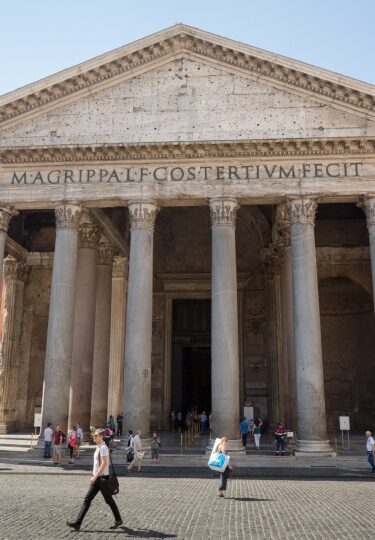Even if you have never been to Rome before, you will be familiar with its sights from film and literature. None of that, though, will prepare you for the wonder of seeing structures that still awe today, even if they are a shadow of their former glory.
From the Colosseum to the Pantheon, and from the Villa Borghese to the Trevi Fountain, Rome is full of architectural and artistic delights. No one visit can take it all in, and perhaps no one lifetime.
Whether it’s your first time in Rome, or your 50th, there is always something to learn about its history. And, even without archaeologists digging up new treasures every day, there will always be a new thing to see.
Here are some of the most fascinating Rome landmarks to discover.
The Colosseum
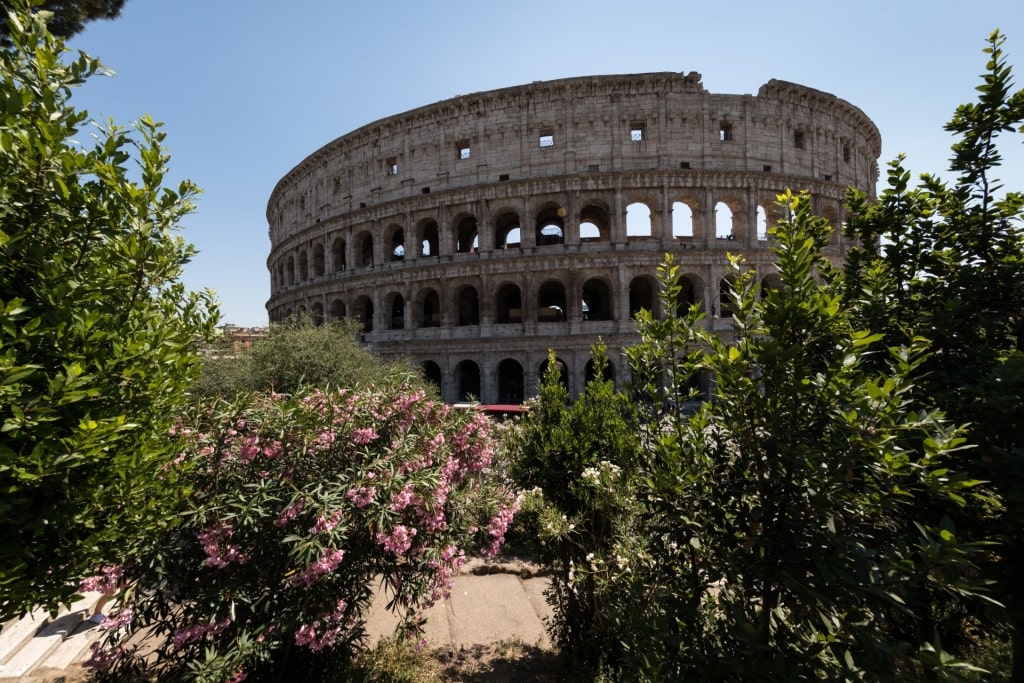
The Colosseum
Italy is known for Rome’s antiquities, particularly the Colosseum. This oval amphitheater is the largest ever built, holding up to 80,000 spectators. It dates to the year 72 AD, and was the setting for gladiator combat and major public events.
Vast underground spaces held the hundreds of animals and props used in these spectacles. However, their construction stopped the former flooding of the arena for use in mock naval battles.
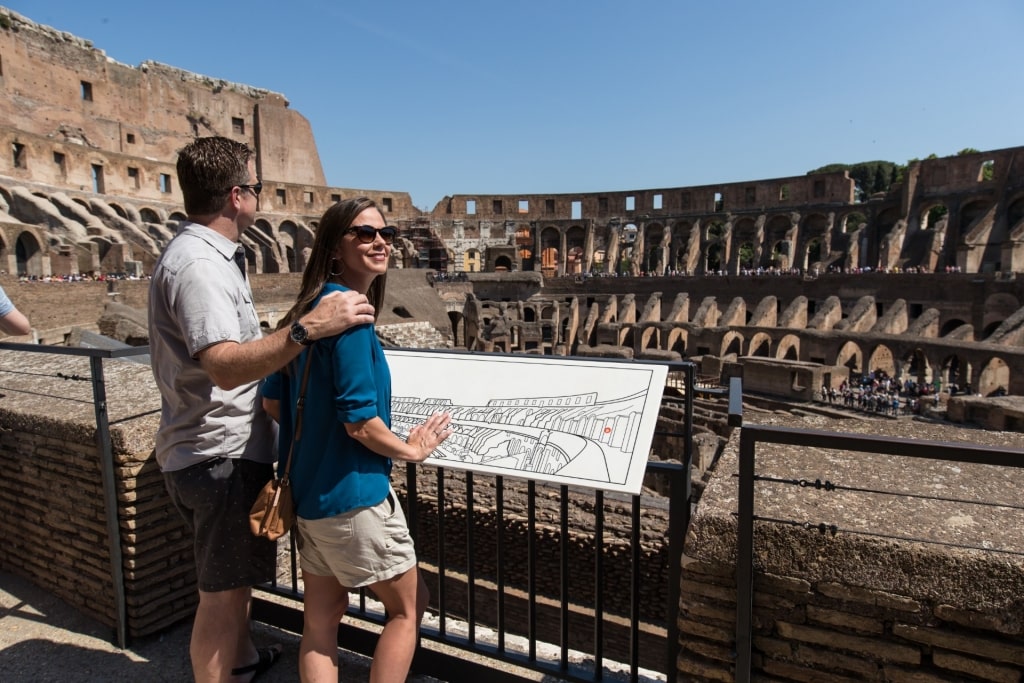
The Colosseum
As impressive as the Colosseum is, much of its stone fabric has been removed to build other structures in the city. The metal binding holding those stones together was also salvaged over the centuries.
Castel Sant’Angelo
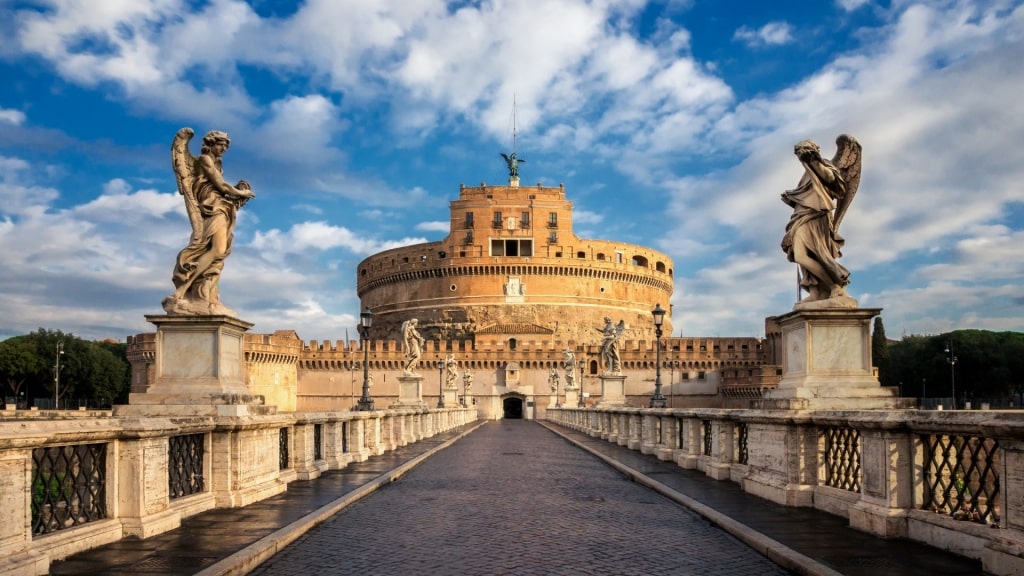
Castel Sant’Angelo
This landmark circular tower was built in 139 AD as a mausoleum for the Emperor Hadrian—he of the famous wall in England. Romans still call it “il Mole Adriano”, or Hadrian’s Edifice.
In 401, it was converted into a military fortress, a strongpoint as Rome’s walls were strengthened against the Barbarians. It later became a papal castle for times of siege (the Passetto di Borgo connects it to Saint Peter’s Basilica), and is now a Roman museum.
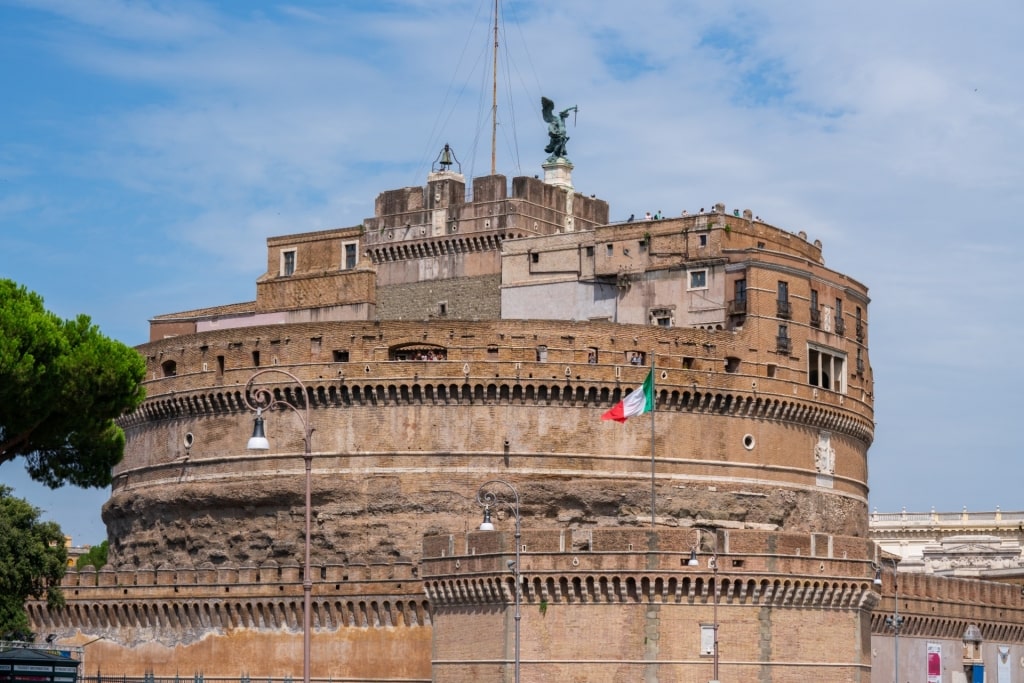
Castel Sant’Angelo
Once the tallest building in the city, Castel Sant’Angelo is still worth the stop just to see the views from the battlement. Classical music lovers will also want to see the tower from which the tragic Tosca jumped to her death in Puccini’s opera.
Read: Best Castles in Italy
Roman Forum
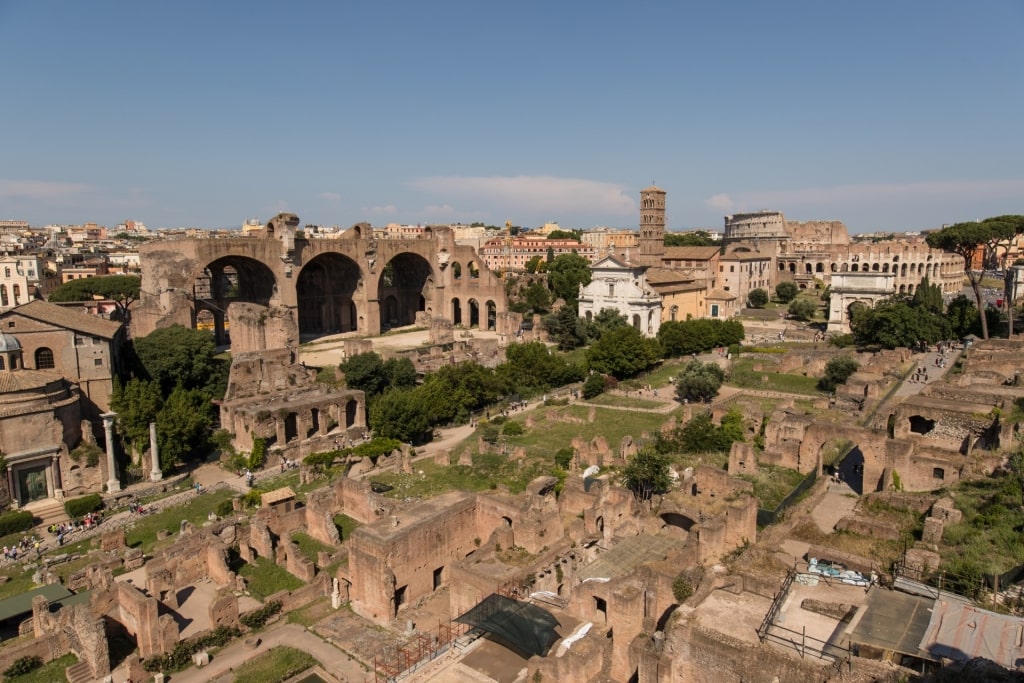
Roman Forum
Originally a marketplace, the forum was eventually the religious, legal, political, and social center of Ancient Rome. At a time when “all roads lead to Rome”, this is where they converged.
The Curia (Senate), major temples, and the Rostra, a public speaking platform, all stood here. In the centuries since, much of the stone and marble proved too tempting a resource for the builders of Rome’s churches and other grand structures.
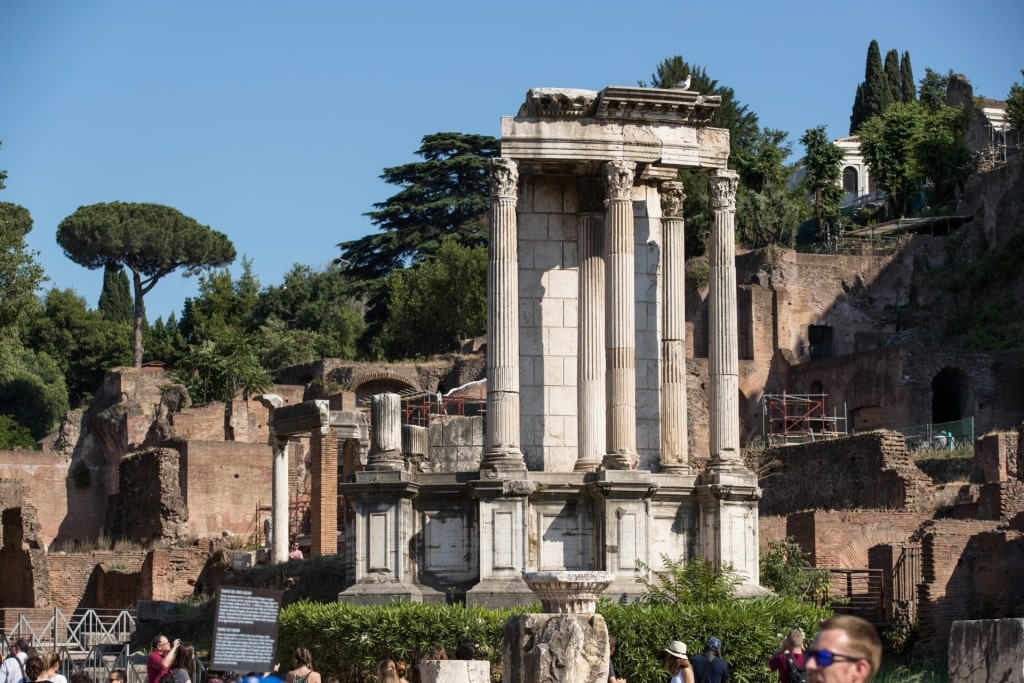
Temple of Vesta, Roman Forum
Fortunately, the Temple of Vesta, the Basilica of Maxentius, and The Temple of Saturn remain to give a vivid impression of what has been lost. It does not take too much imagination to cast your mind back and repopulate them with those Romans of long ago.
The Pantheon
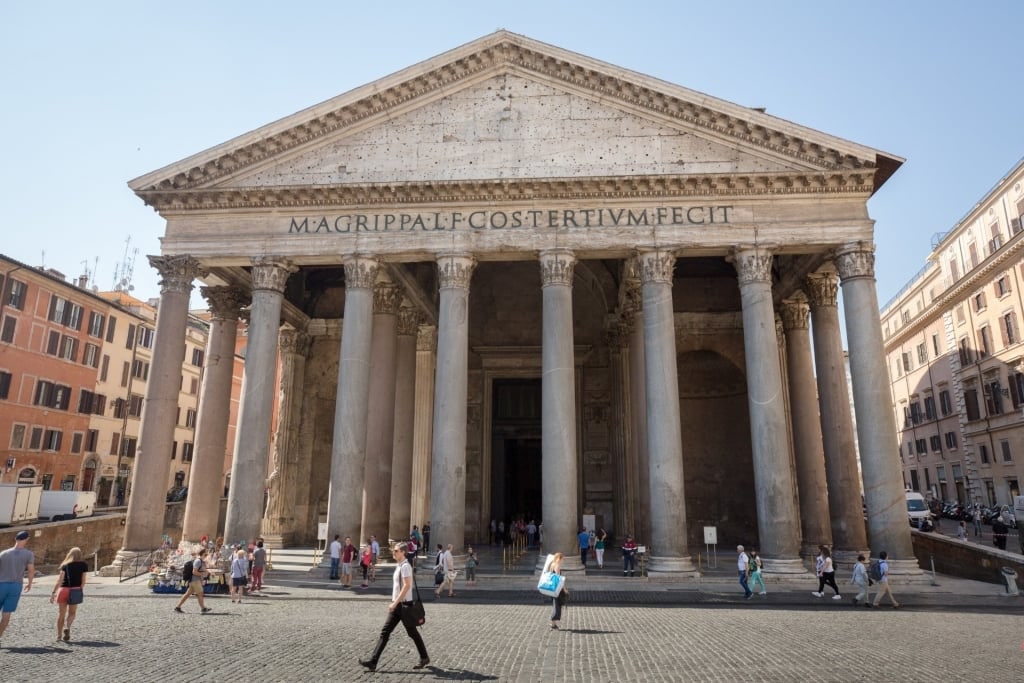
The Pantheon
The Pantheon has the largest dome ever built before modern times. No one knows exactly how this engineering feat was accomplished in the early second century.
It was a temple, dedicated to all the gods (pan is Greek for “all”, and theos means “god”). In 609, it was rededicated as a church, named Santa Maria Rotonda.
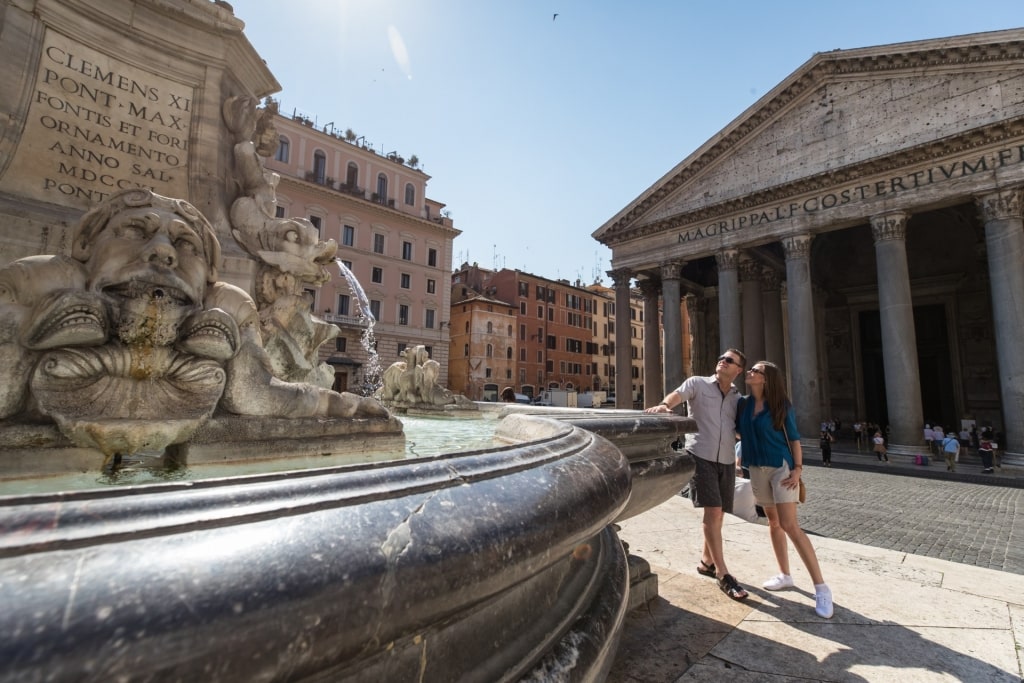
The Pantheon
Thomas Jefferson, among many other architects around the world, was inspired by this famous European landmark. You can see its influence in the U.S. Capitol, the Jefferson Memorial, and the National Gallery in Washington, D.C.
Trevi Fountain
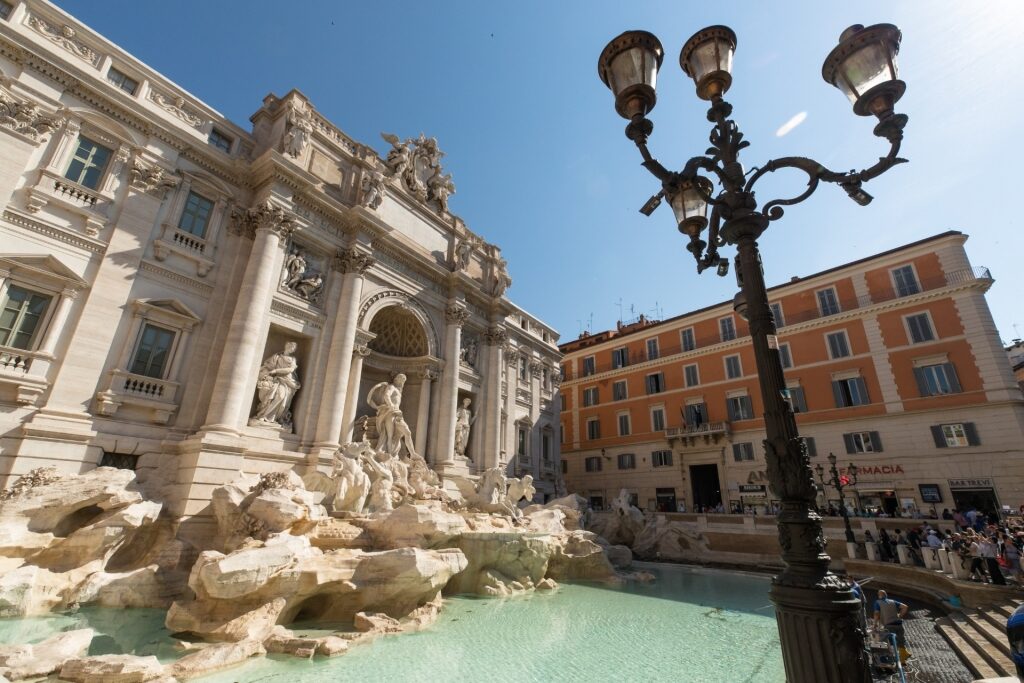
Trevi Fountain
This beautiful Baroque landmark is 85 feet high and 160 feet wide, and seems even bigger when you come upon it via the narrow surrounding streets. Built at the end point of the Aqua Virgo aqueduct, it is made of the same travertine stone used for the Colosseum.
The central statue is Oceanus, the god of the River Oceanus that wraps the Earth and supplies all its fresh water. His shell-shaped chariot is borne by two seahorses, one tame, one wild, that symbolize the moods of water.
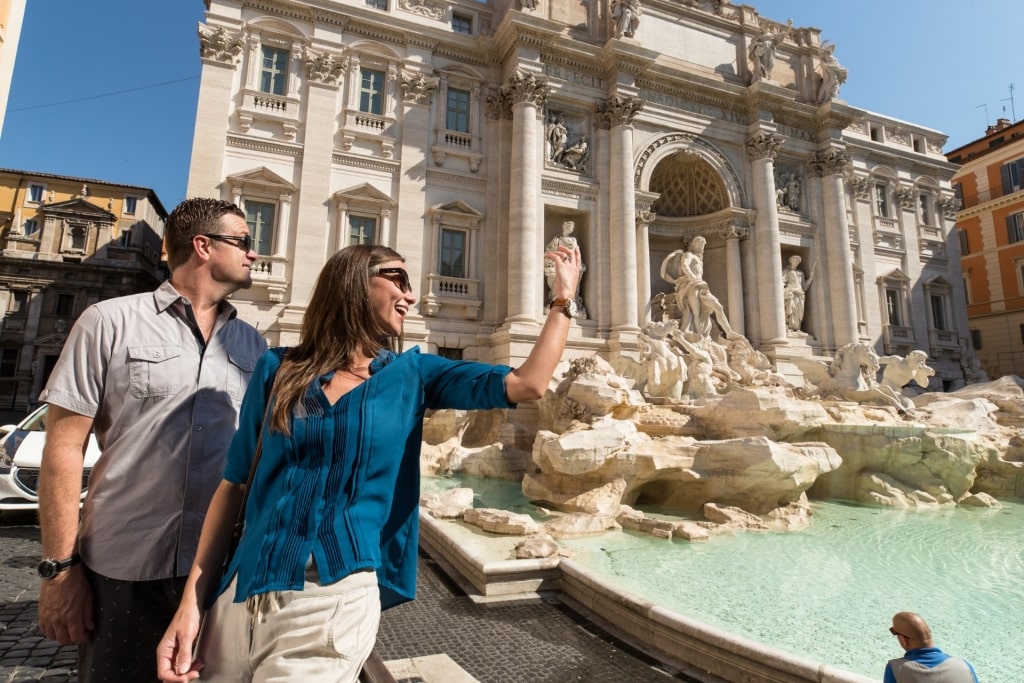
Trevi Fountain
A tradition says that throwing a coin in the fountain brings good luck, and ensures a return to Rome. The coins are regularly collected and used to support various charities for the city’s poor.
Piazza Navona
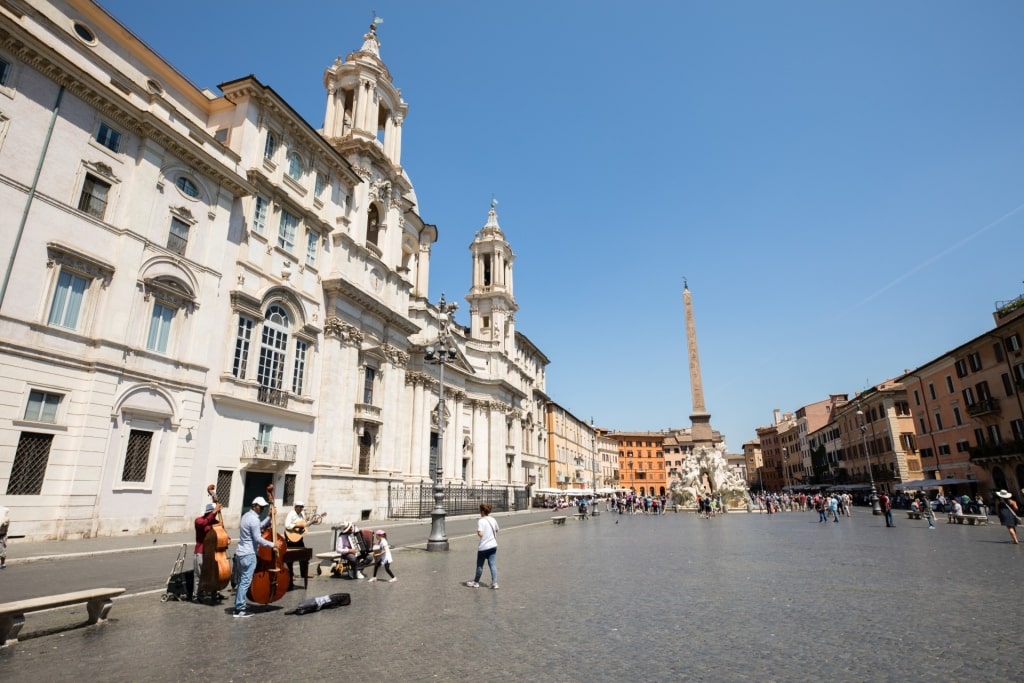
Piazza Navona
When you stand in Piazza Navona, you are in the former Stadium of Domitian, an athletics area from the first century. Its terraces stood where the surrounding buildings are now, many of them constructed with the original stones.
The existing Piazza was laid out in the 15th century, and its name is a corruption of Agonalis, or “competition”, from its former use. Its central feature is Bernini’s Fountain of the Four Rivers, added in 1651.
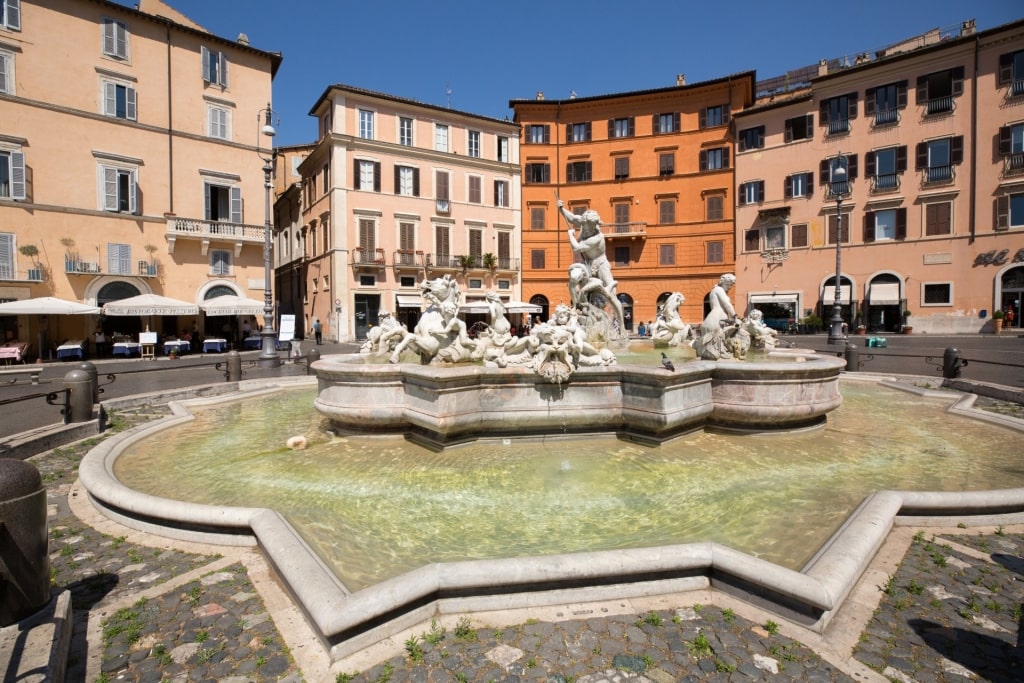
Fountain of Neptune, Piazza Navona
That 17th century makeover left the piazza with its present Baroque architecture, particularly its churches. Two other fountains—Fontana del Moro and Fountain of Neptune—also showcase Baroque art.
The entire square, meanwhile, is lined with outdoor cafés and restaurants, and is a popular meeting place.
Read: What to Eat in Rome
Arch of Constantine
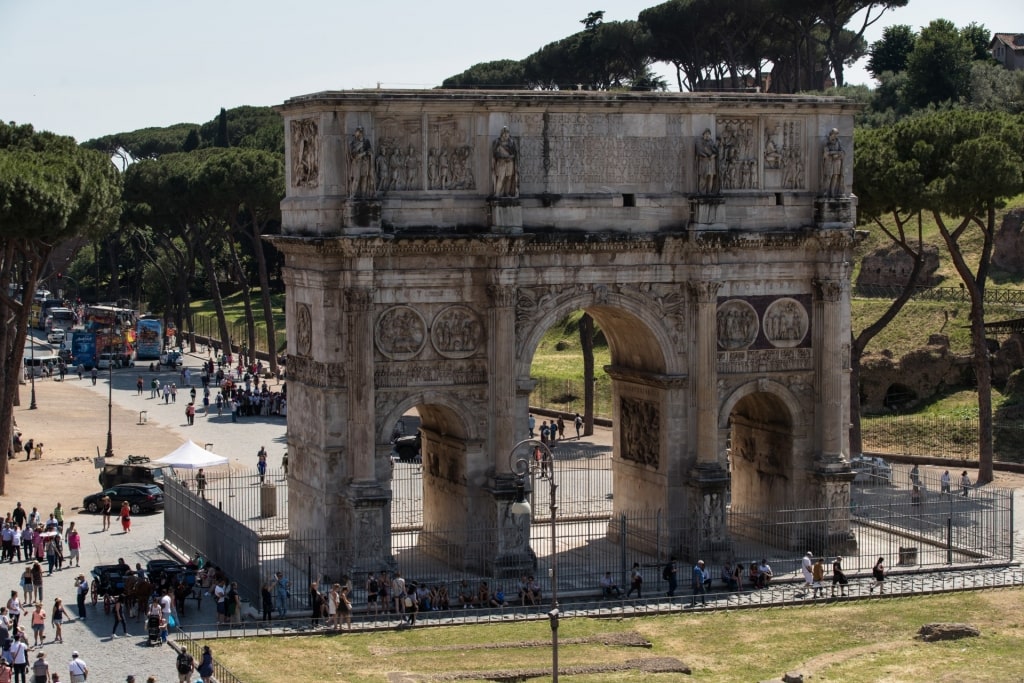
Arch of Constantine
Built in 315, this arch dates to a time when Rome was in a state of great transformation. Constantine was the emperor who decriminalized Christianity and the arch celebrates his victory at the Battle of Milvian Bridge in AD 312, which made him sole ruler of the Roman Empire. It’s a massive 70 feet high, made of concrete faced in marble.
Much of its decorative sculpture was recycled from earlier, second century works. That may have been for the purpose of economy, or to show the continuity of the Roman Empire in times of change.
Spanish Steps
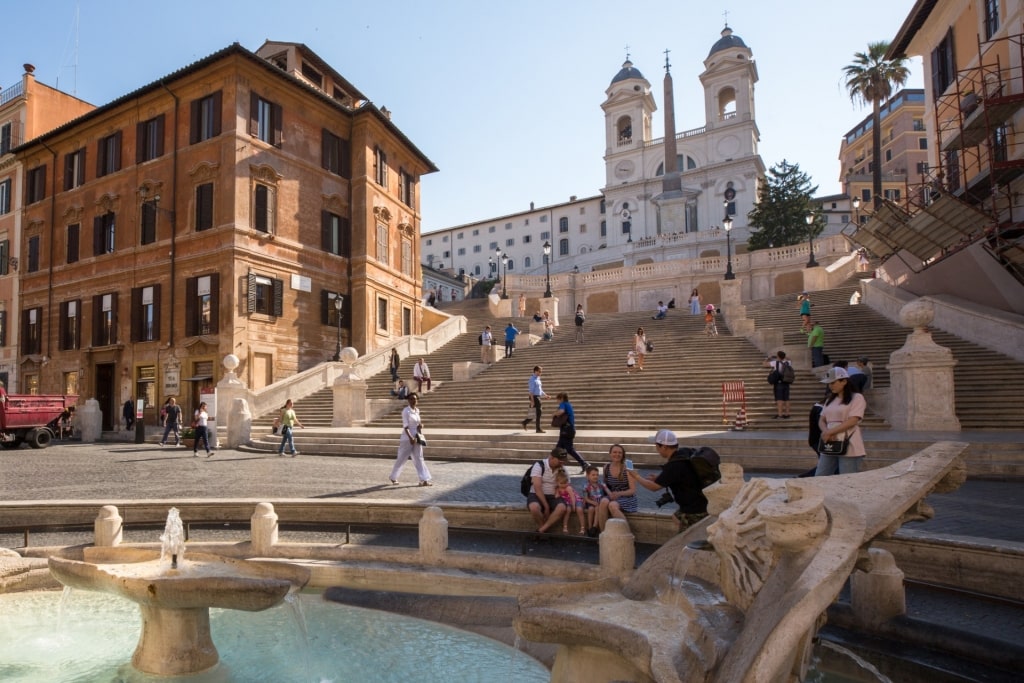
Spanish Steps
These steps were originally conceived to mark a 1559 peace treaty between France and Spain. Unfortunately, war broke out again before work started and it took until 1726 to build them.
The smooth steps connect the French church of Trinità dei Monti to the Piazza di Spagna at the bottom. Piazza di Spagna is home to the Embassy of Spain to the Holy See, the oldest embassy in the world.
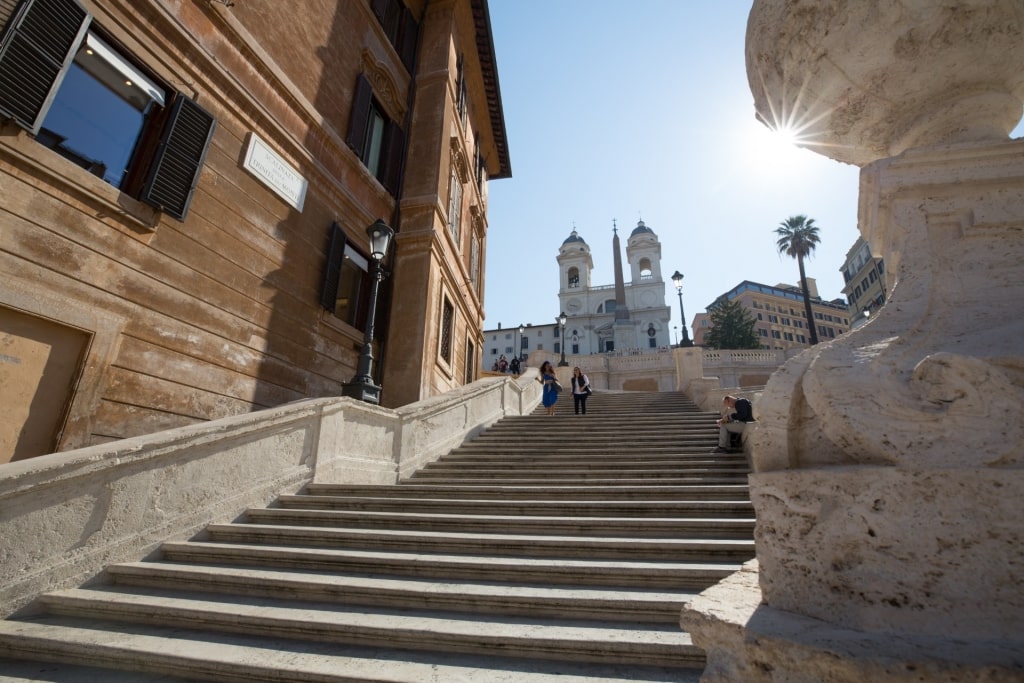
Spanish Steps
The 138 marble steps must be one of the most photographed Rome landmarks, made famous by artists and filmmakers. Their fame somewhat eclipses the remarkable Fontana della Barcaccia, a fountain designed by Pietro Bernini, father of the Baroque sculptor.
Villa Borghese
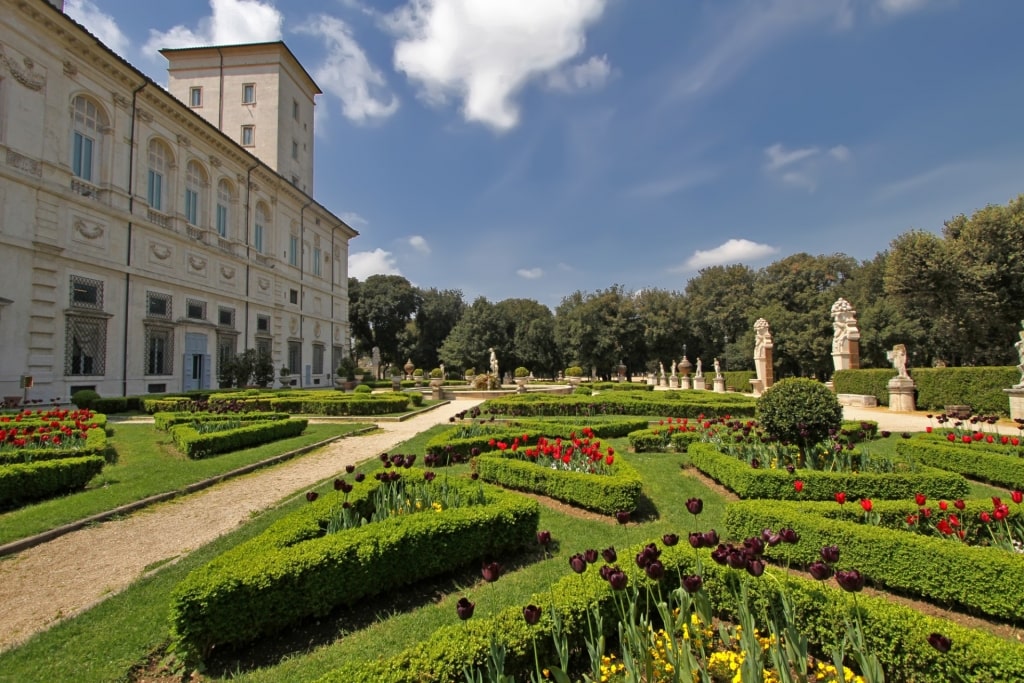
Villa Borghese
Villa Borghese was built by Scipione Borghese (1577-1633), patron of the painter Caravaggio and the sculptor Bernini. It was once a villa on the outskirts of Rome (a palazzo is a villa within the city), but has been swallowed up since.
His amazing art collection is now displayed in the Galleria Borghese. It holds wonders like Caravaggio’s David With The Head Of Goliath.
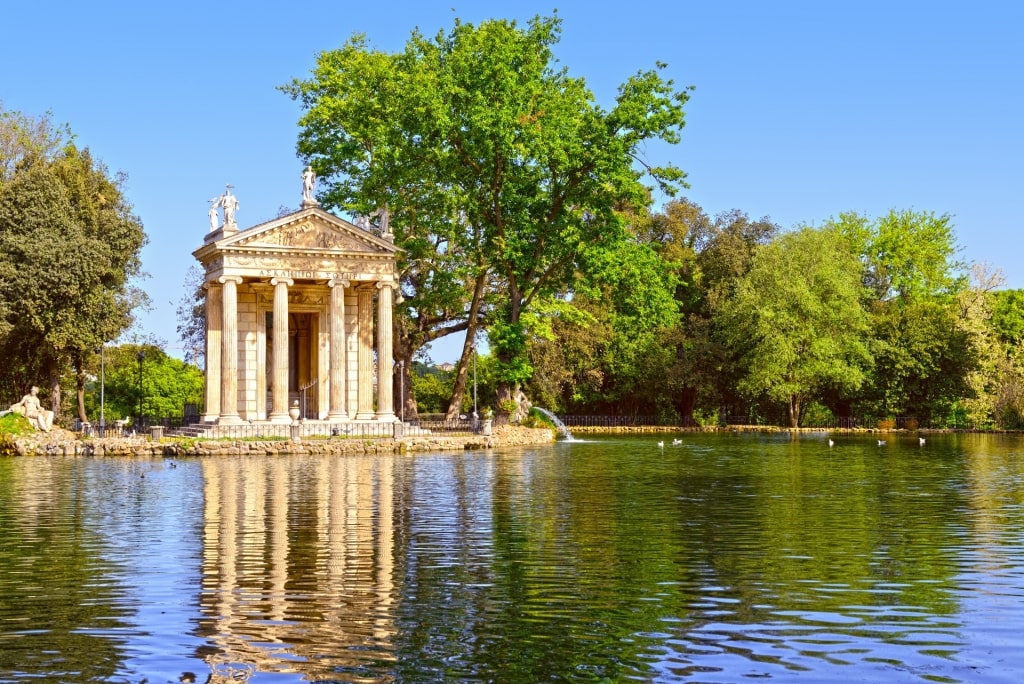
Villa Borghese
The Italian gardens are also open to the public, making up one of Europe’s largest urban parks. Filled with sculpture and fountains, their shade is a welcome break from Rome’s heat in summer.
Unsurprisingly, this is a popular picnic spot in Rome for families and couples wanting to have a relaxed day out.
Appian Way
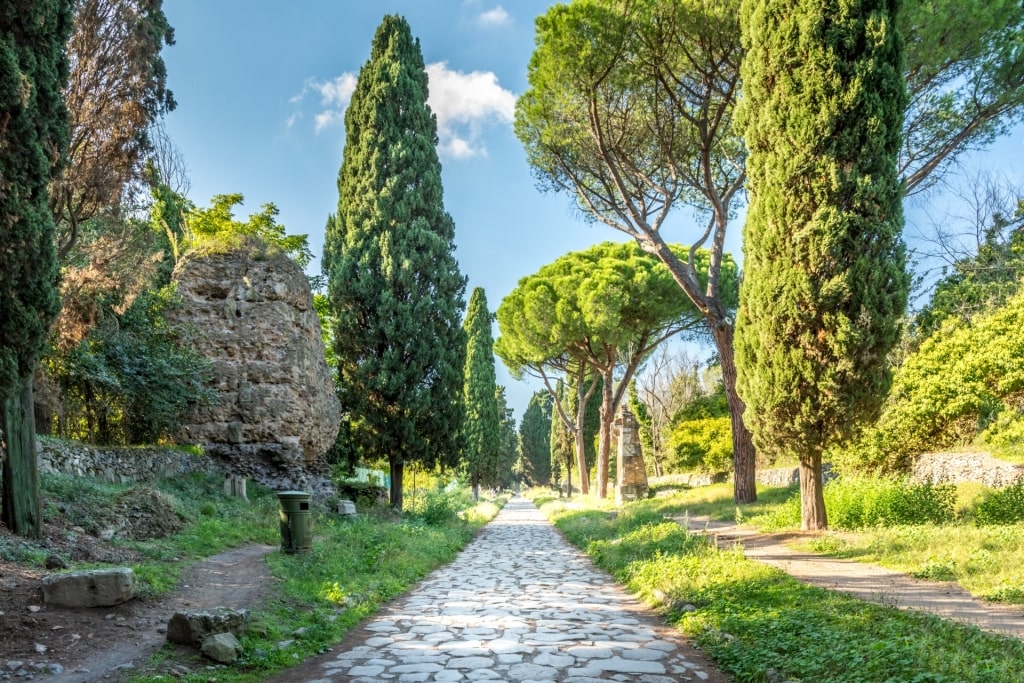
Appian Way
The 350-mile-long Appian Way was the world’s first super highway, linking Rome to the important southern port of Brindisi. Started in 312 BCE, it survives today as the Via Appia Antica.
The first few miles outside Rome are now an archaeological park, lined with the famed Catacombs and other monuments. Parts are still open to local traffic (except on Sundays) but you can safely walk it, or cycle on the antique paving.
Cypress trees shade these sections where you can still see the tracks worn by ancient wagons. A highlight is the “Domine Quo Vadis?” church on the spot where St. Peter encountered a vision of Jesus Christ.
Baths of Caracalla
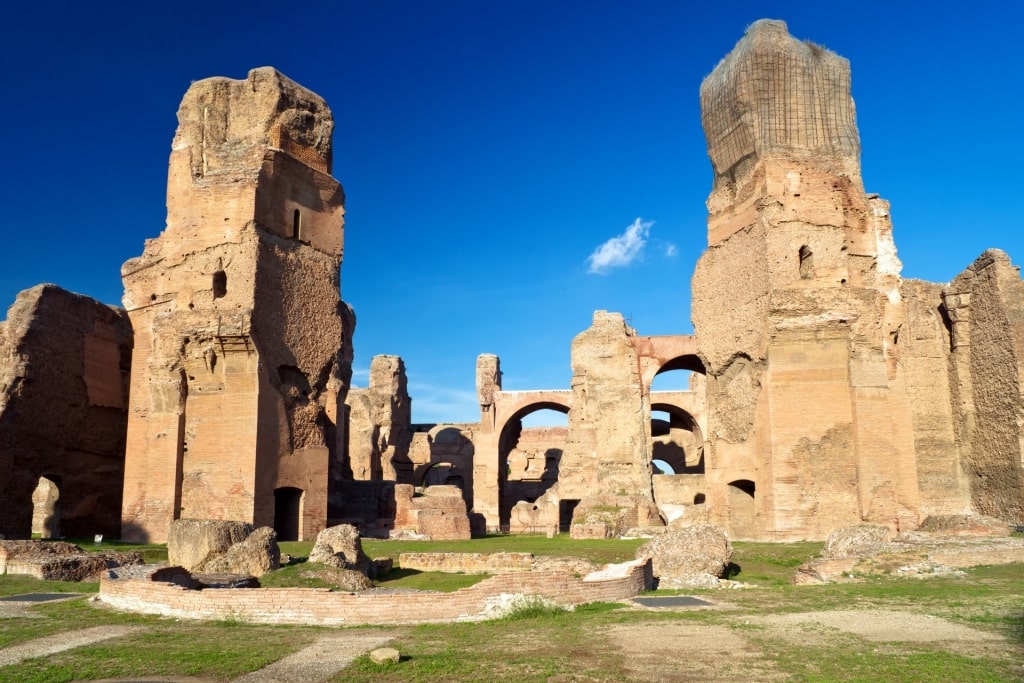
Baths of Caracalla
Inspiration for the original Pennsylvania Station in New York, the Baths of Caracalla stand near the Circus Maximus. More than 120 feet high, they have been stripped of their opulent decor through the centuries, but still impress as one of the best places to explore Rome off the beaten path.
Built in 216, the baths had two libraries, a gym, and a spa. Seneca the Younger described “the bathers who love to make big splashes when they jump in the pool”.
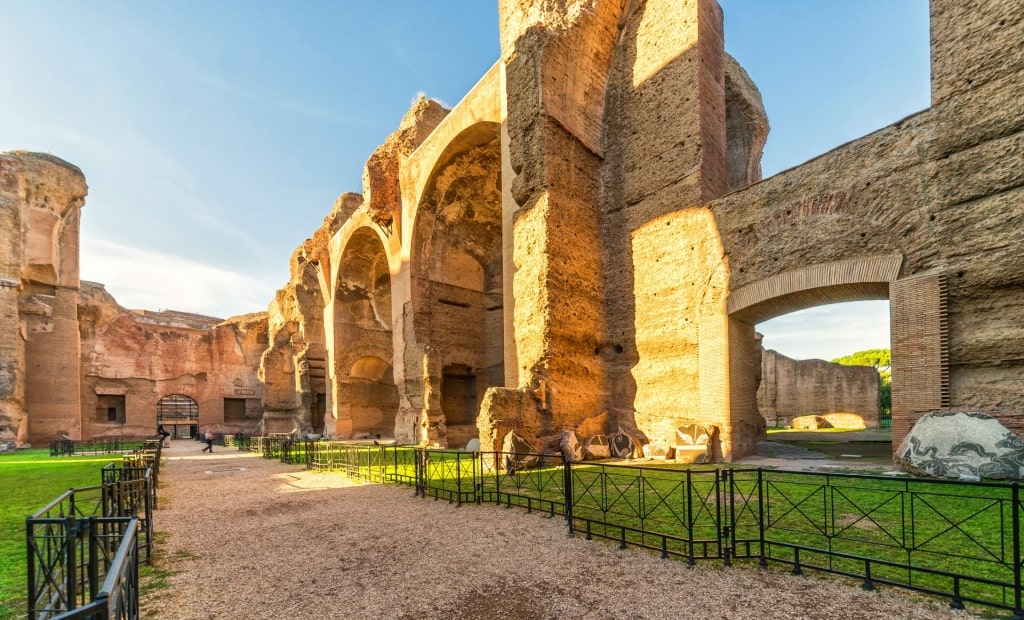
Baths of Caracalla
Impressive as they are above ground, there are tunnels underneath built wide enough for two wagons of firewood to pass each other. The baths could hold 1,600 people — yet the structure was half the size of Baths of Diocletian, a structure that now houses the church of Santa Maria degli Angeli.
Santa Maria Maggiore Basilica
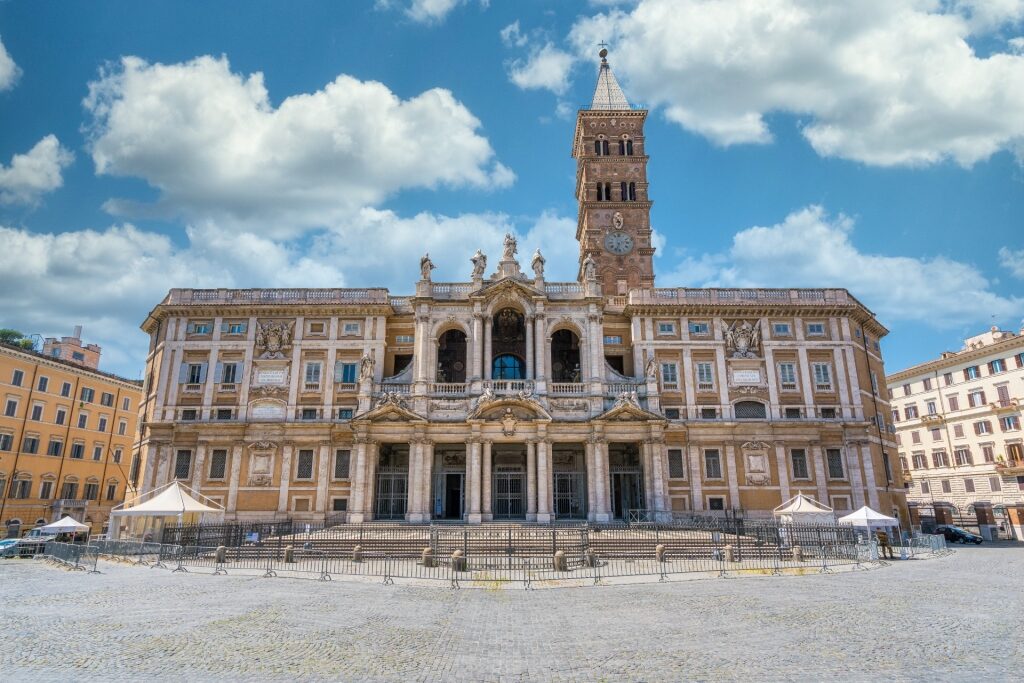
Santa Maria Maggiore Basilica
Santa Maria Maggiore Basilica is another church built on a temple, this time dedicated to the mother goddess Cybele. It’s the largest (hence “maggiore”) of the 26 churches in Rome named for the Virgin Mary.
Its design and decor are an interesting mix of style, from Christian to Baroque. Roman columns, medieval mosaics, Renaissance ceilings and Baroque flourishes somehow combine into a coherent whole.
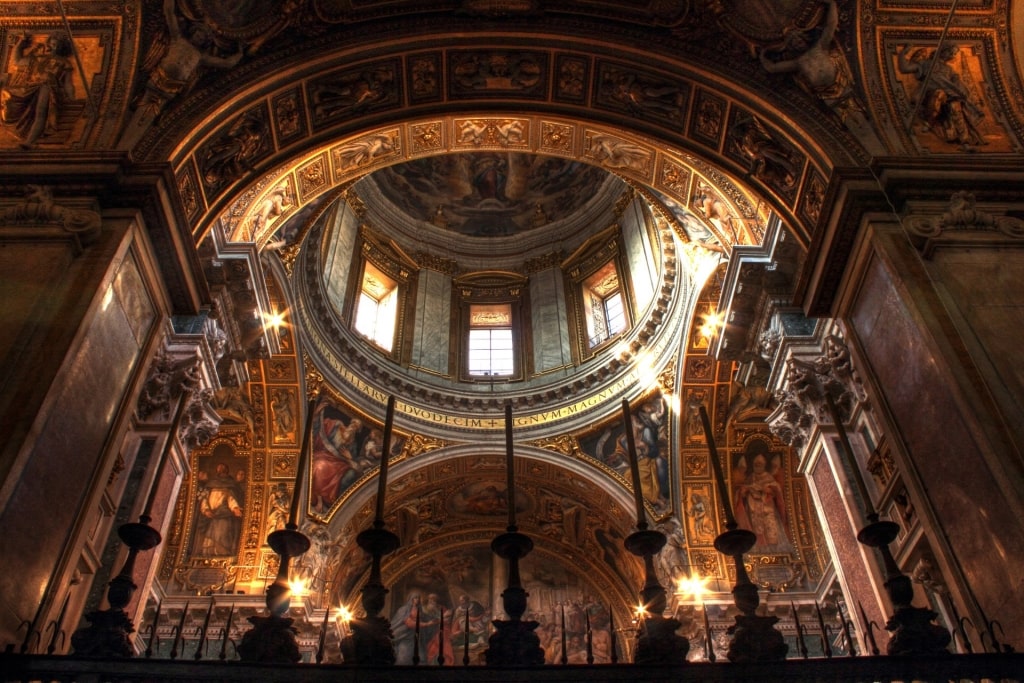
Santa Maria Maggiore Basilica
If you have a good guide, the church is a primer of architecture and Christian art through the centuries. They will also point out details like the ceiling covered with gold Columbus brought back from the “New World”.
Teatro Marcello
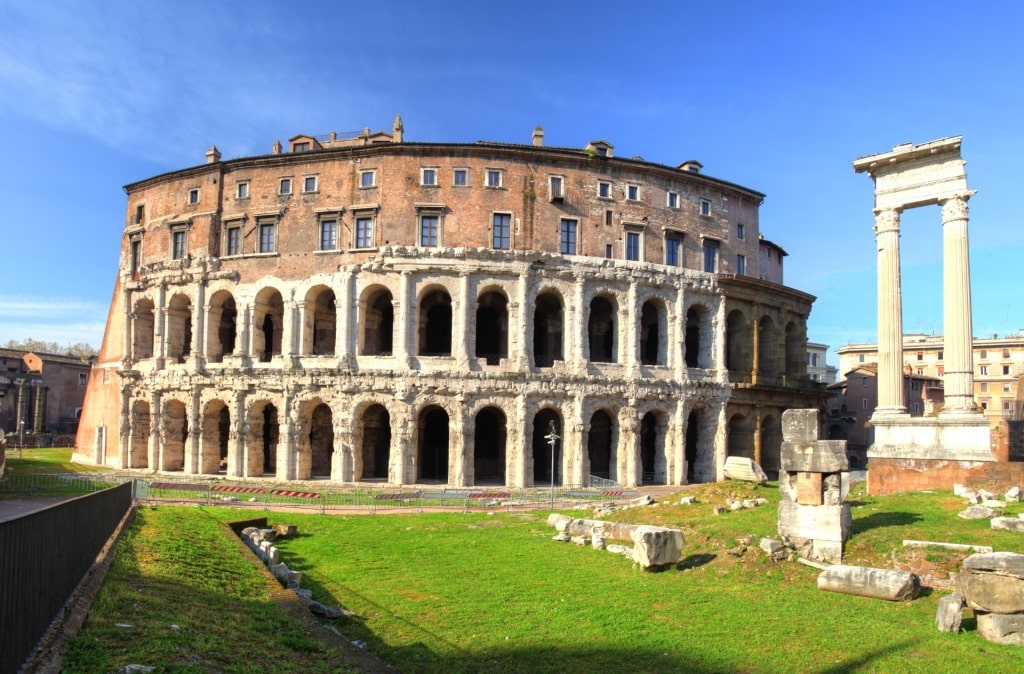
Teatro Marcello
Its top floor now private apartments, the Theatre of Marcellus was once the largest in the Roman Empire. Built in 13 BCE, it could hold some 20,000 spectators.
Constructed on land cleared by Julius Caesar, the theater was finished by the emperor Augustus and named after his nephew, who had died at the age of 19.
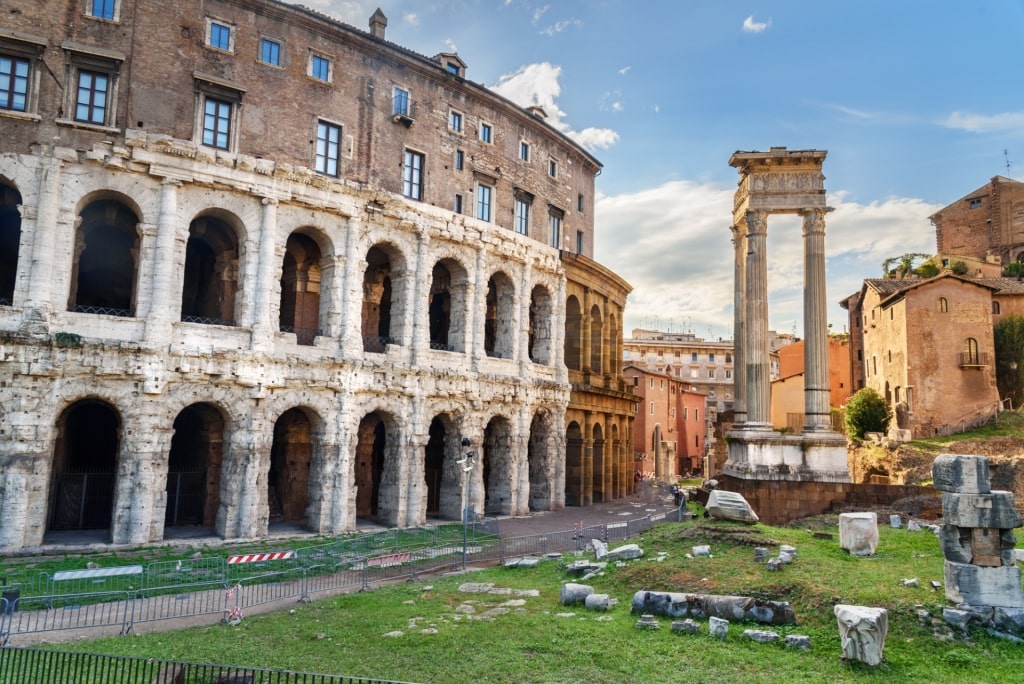
Teatro Marcello
Built from concrete and faced in white travertine, the theater is also notable for the first known use of fired brick in Rome. Augustus borrowed this building staple from the Greeks, who had discovered its many advantages over sun-dried brick.
Santa Maria in Cosmedin
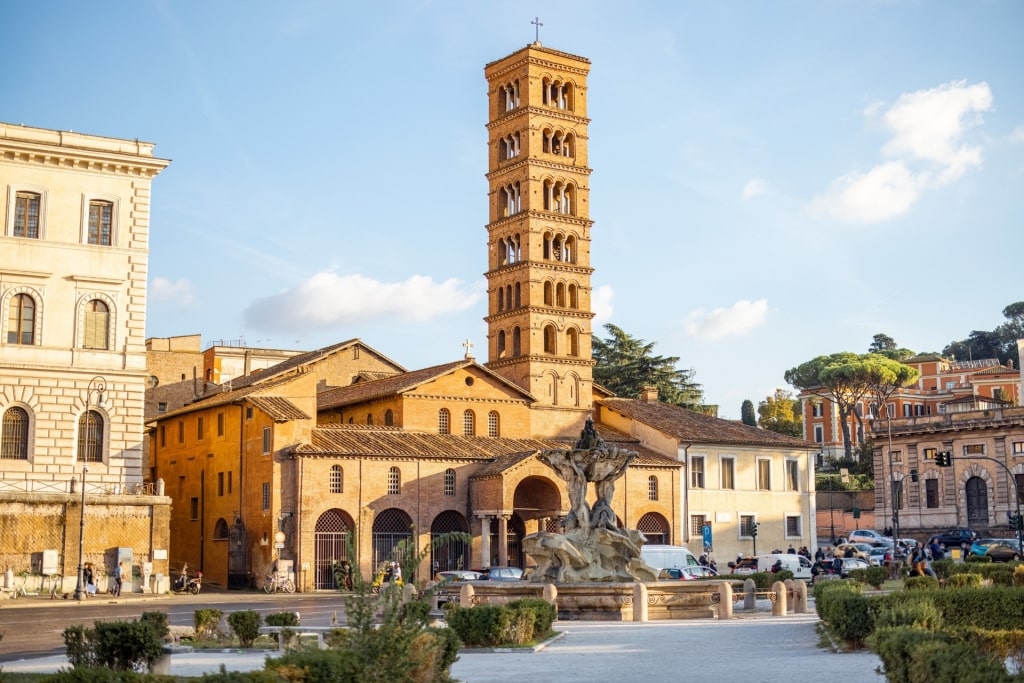
Santa Maria in Cosmedin
Gregory Peck helped make this church famous when he ”lost” his hand in its Bocca della Verità (“Mouth of Truth”). By entertaining Audrey Hepburn, he started a tourism boom that remains to this day.
The massive mask of the sea god Oceanus is on the portico, but inside, the church is much quieter. It holds the skull of Saint Valentine, a third-century Roman saint better known nowadays for his support of the flower and greeting card industry.
Santa Maria was built over a temple dedicated to Hercules Invictus, and much of its marble was repurposed in the floor and pillars. Cosmedin means “ornate”, a clue as to the beauty of the result.
Read: Best Roman Ruins Around the World
Ostia Antica
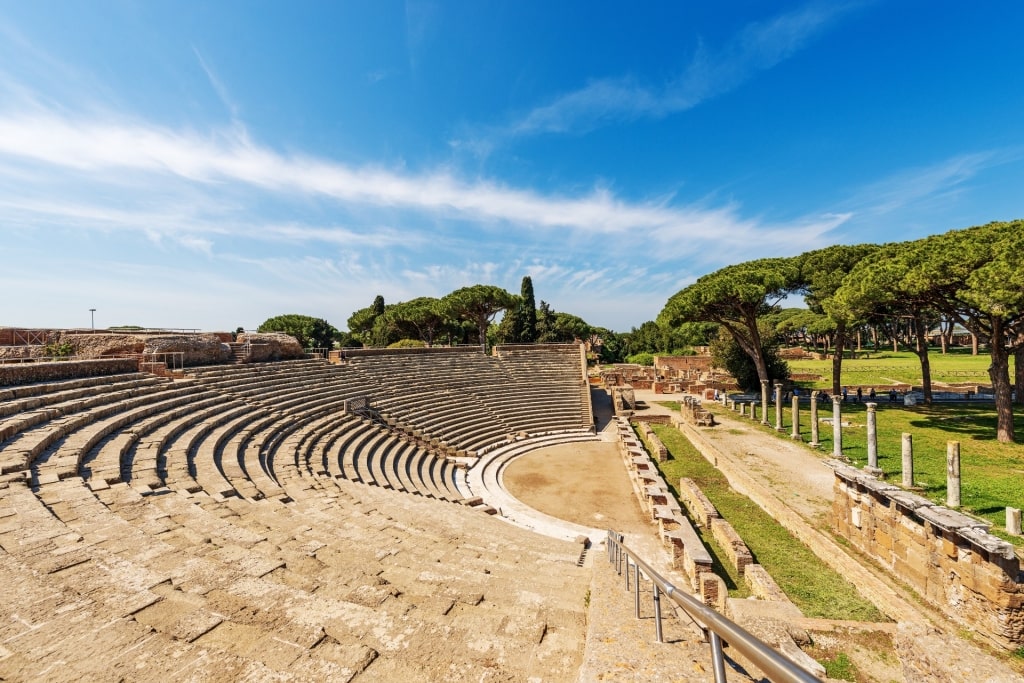
Ostia Antica
Rome’s former port on the mouth of the River Tiber is incredibly well preserved. Unlike Pompeii or Herculaneum, it was never destroyed by natural events but was abandoned as Rome itself fell into decline.
Two-thirds of the site is yet to be excavated but what has already been revealed is remarkable. Warehouses and two-story apartment blocks still stand, and mosaic floors still advertise shipping companies.
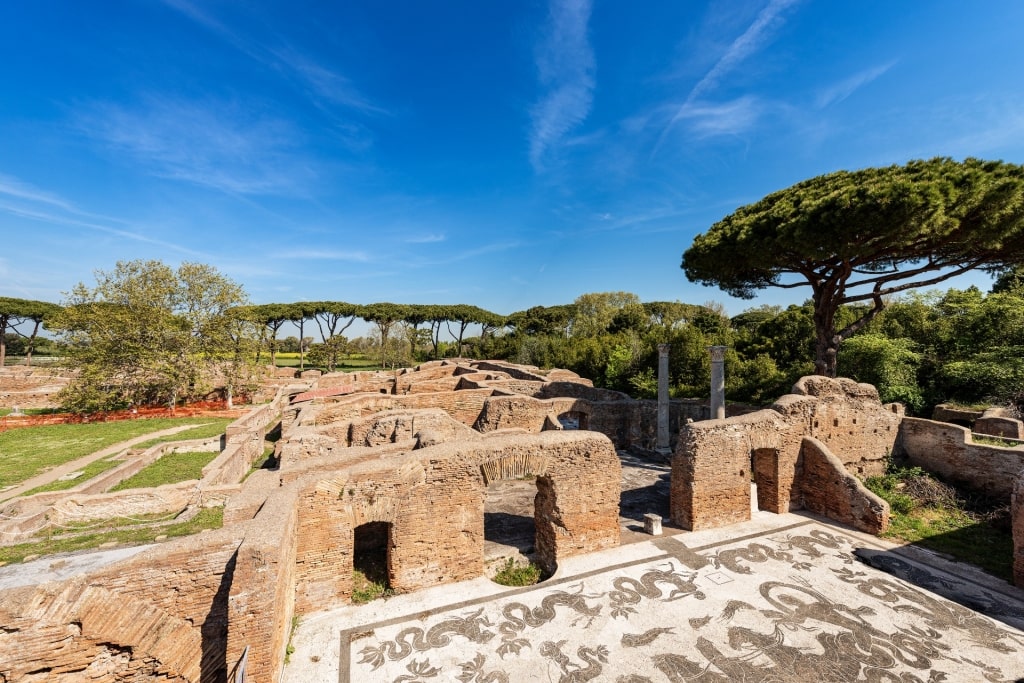
Bath of Neptune, Ostia Antica
The Bath of Neptune is a complete Roman bath, with its Temple of Mithras later a 4th-century Christian church. One villa has frescoes of chariot racing teams in their red, white, green, and blue colors.
Read: Best Day Trips From Rome
Parco dei Acquedotti
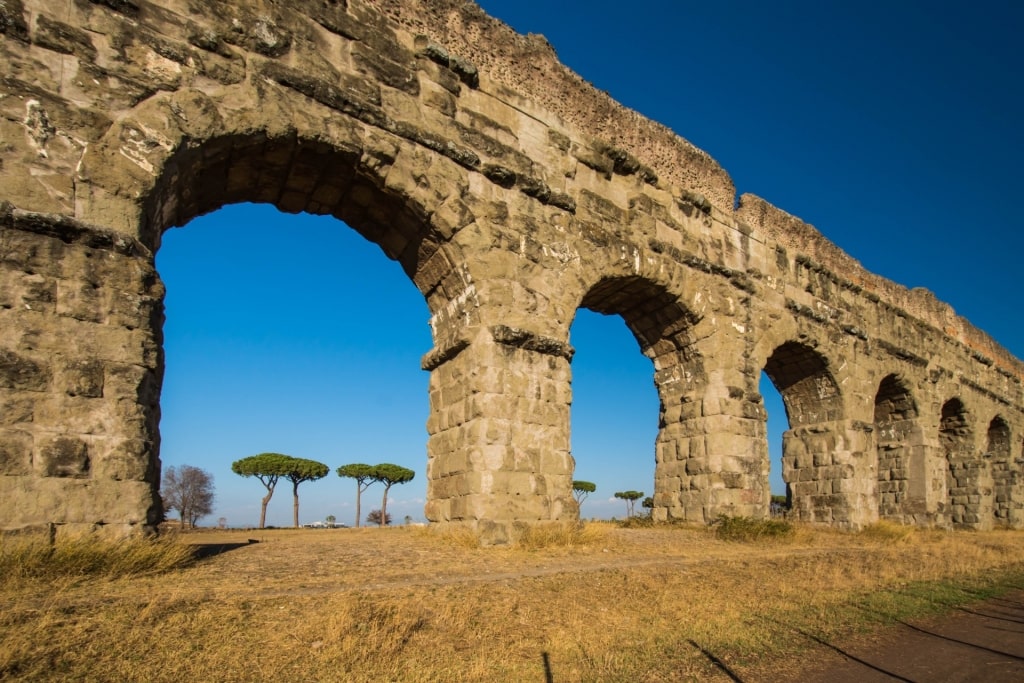
Parco dei Acquedotti
The Aqueduct Park is on the edge of Rome, near the Appian Way, and has remains of seven of its 11 historic aqueducts. Some still carry water from sources up to 60 miles away.
The 16th-century Acqua Felice was built atop the Aqua Marcio, which dates to 144 BCE. That older aqueduct was broken by the Goths in their siege of 537 AD, the beginning of the end of Ancient Rome.
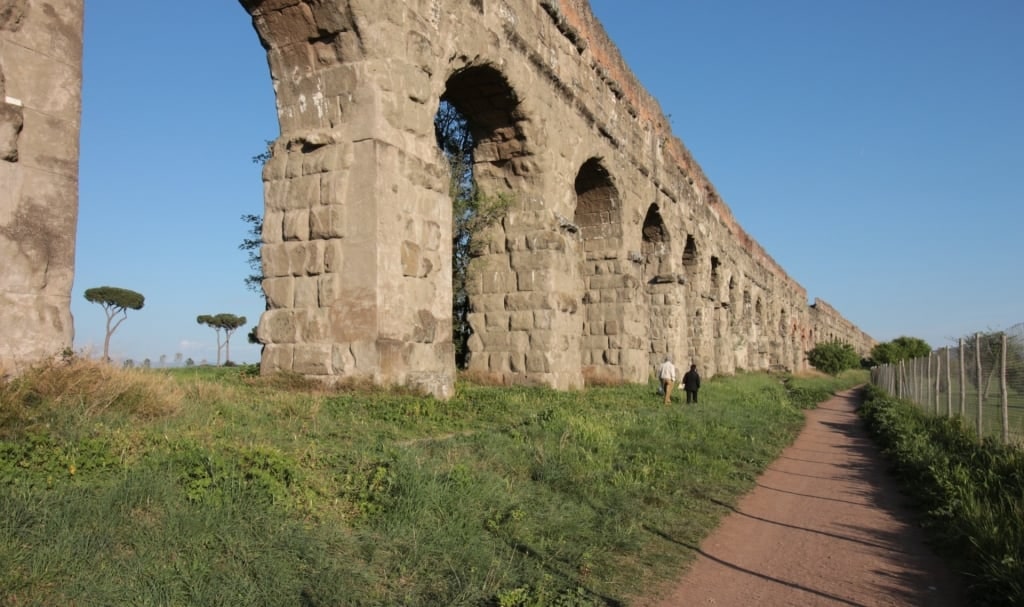
Aqua Claudia, Parco dei Acquedotti
The most impressive is the Aqua Claudia, which was finished in 52 AD. Most of its 43 miles were underground, but you can see a long, elevated section here, parts of which reached 100 feet in height.
San Nicola in Carcere
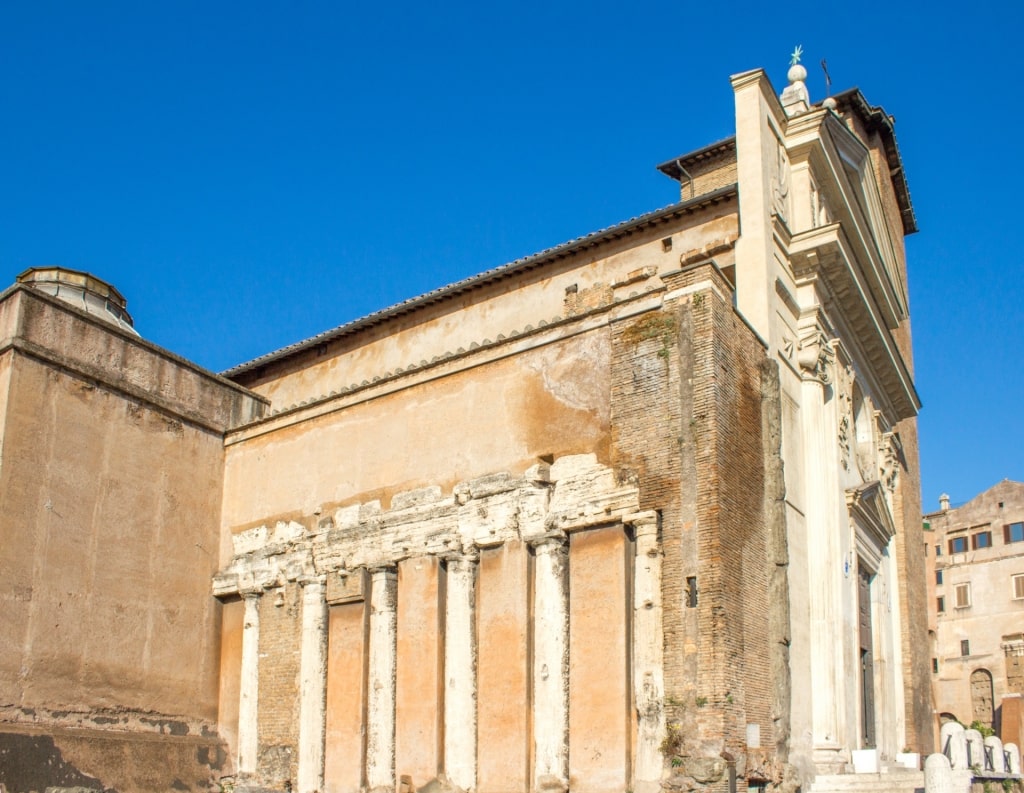
San Nicola in Carcere
“St. Nicholas in Prison” is built over the remains of three ancient temples, part of which can still clearly be seen in its walls. It stands in what was once the Forum Holitorium, Ancient Rome’s vegetable market.
Its ornate interior is well worth a look for anyone who loves churches. Look out for the 14 different columns lining its three naves, all of which have been repurposed from the temples.
In its crypt, you can see the Temple of Janus from 260 BCE and the Temple of Juno, from 195 BCE. Turned into a church around the 13th century, it was dedicated to St. Nicholas by the local Greek community—but why “in prison” remains a mystery.
Victor Emanuele II Monument
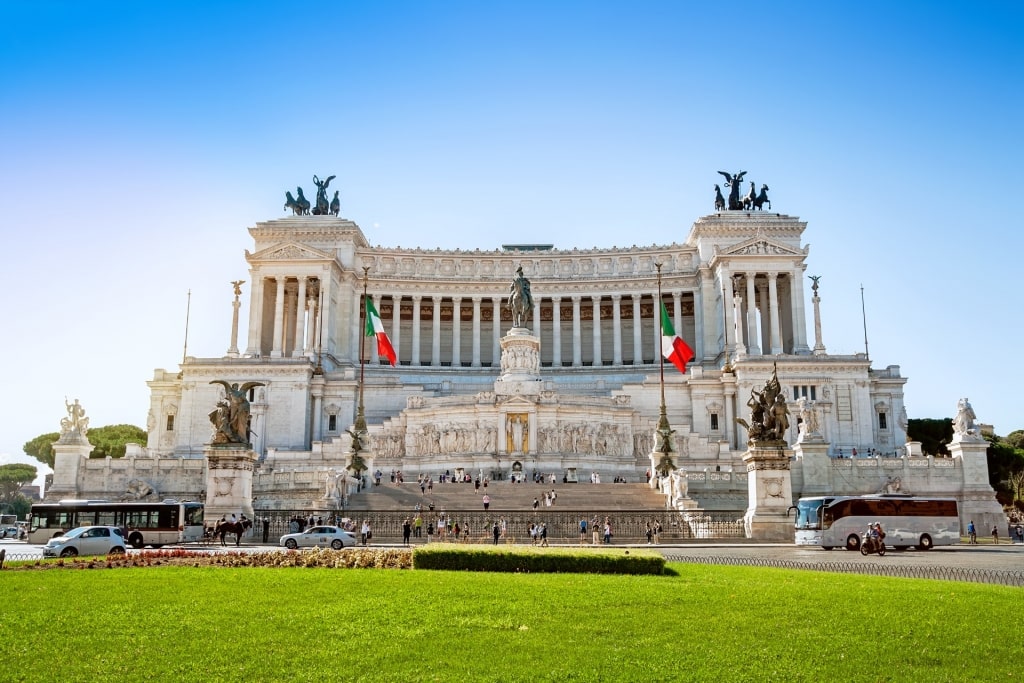
Victor Emanuele II Monument
Possibly the least-loved monument in the Italian city but impressive nonetheless, the glaringly white Monumento Nazionale a Vittorio Emanuele II is faced in Brescia marble. That contrasts sharply with the honeyed travertine used for Rome’s ancient buildings.
Its Renaissance style does not fit in with its classical neighbors, either; it’s nicknamed “The Wedding Cake” and “The Typewriter” by locals. Romans have a troubled relationship with this “Altar of the Fatherland”. But take the glass elevator to the rooftop café and you’ll enjoy one of the best panoramas of Rome.
Read: Shopping in Rome: The Ultimate Guide
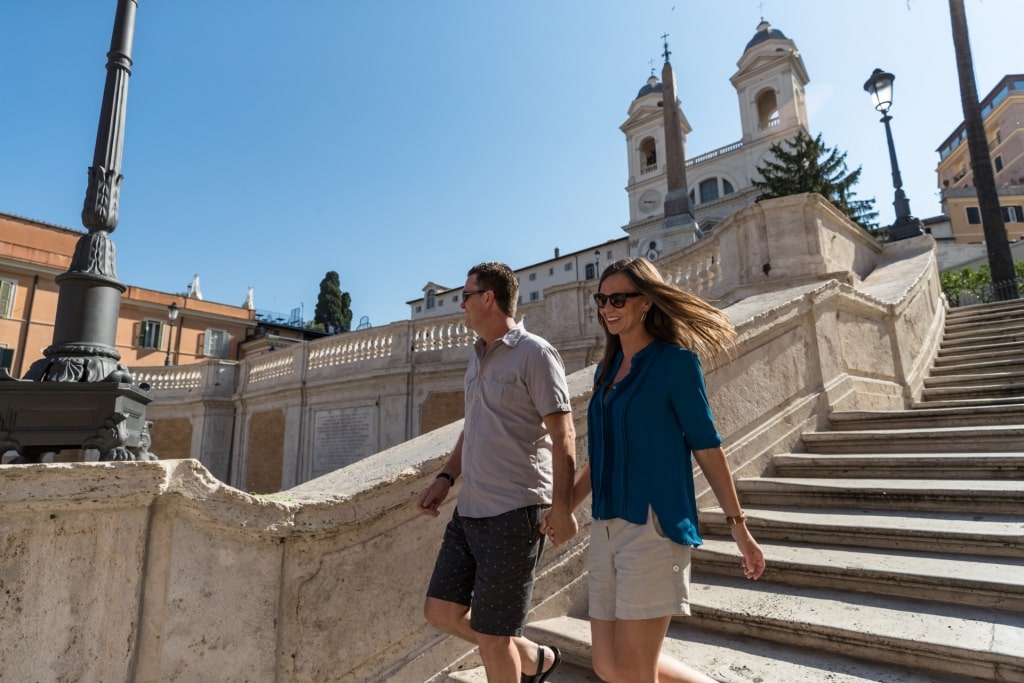
Spanish Steps
Inspired by these Rome landmarks to visit the Eternal City? Then browse through Celebrity’s cruises to Rome to find a cruise that will showcase the very best Italy has to offer.
